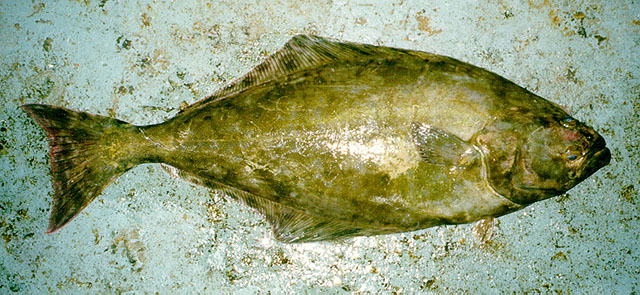| Pleuronectidae (Righteye flounders), subfamily: Hippoglossinae |
| 470 cm TL (male/unsexed); 300 cm TL (female); max.weight: 320 kg; max. reported age: 50 years |
|
demersal; marine; depth range 50 - 2000 m, oceanodromous |
| Northwestern Atlantic: southwestern Greenland and Labrador in Canada to Virginia in USA (Ref. 7251); Northeastern Atlantic: Bay of Biscay to Spitsbergen, Barents Sea, Iceland and eastern Greenland. |
|
Dorsal spines (total): 0-0; Dorsal soft rays (total): 98-110; Anal spines: 0-0; Anal soft rays: 73-85. Uniformly dark brown or black; young marbled or spotted with paler marks (Ref. 4705). |
| Adults are benthic but occasionally pelagic (Ref. 4705). Feed mainly on other fishes (cod, haddock, pogge, sand-eels, herring, capelin), but also takes cephalopods, large crustaceans and other bottom-living animals. Batch spawner (Ref. 51846). Growth rate varies according to density, competition and availability of food. Slow growth rate and late onset of sexual maturity, halibut populations can be seriously affected by overfishing (Ref. 35388). Utilized fresh, dried or salted, smoked and frozen; can be steamed, fried, broiled, boiled, microwaved and baked (Ref. 9988). Also Ref. 58426. |
|
Near Threatened (NT); Date assessed: 12 February 2021 Ref. (130435)
|
| harmless |
Source and more info: www.fishbase.org. For personal, classroom, and other internal use only. Not for publication.
